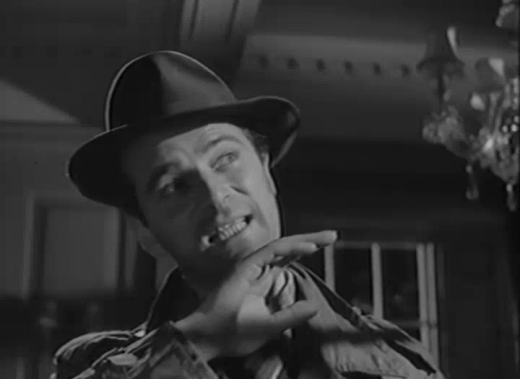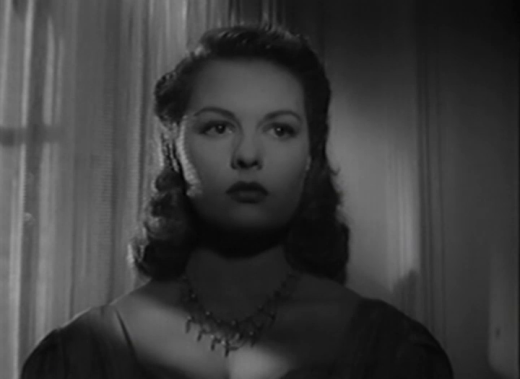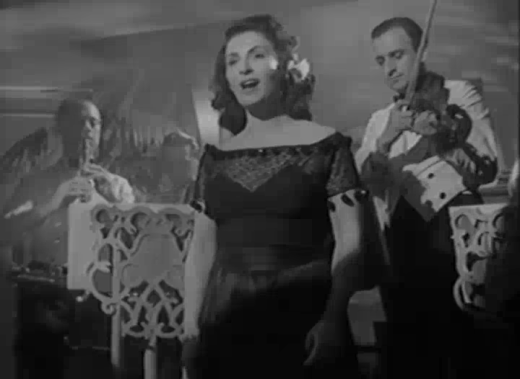UK / 82 minutes / bw / ABPC, Independent Sovereign, Pathé Dir: Lance Comfort Pr: Nat A. Bronsten Scr: Michael Pertwee Story: The Paragon (1948 play) by Roland Pertwee and Michael Pertwee Cine: Wilkie Cooper Cast: Sally Gray, Stephen Murray, Derek Farr, Nigel Patrick, Beatrice Campbell, Seymour Hicks, Marie Lohr, Yvonne Owen, Maria Var, James Hayter, George Woodbridge, Edgar Norfolk, Irene Handl.
It’s a few years after the end of WWII, and Robert Rawley (Murray), a self-made millionaire (or thereabouts), cannot get over the fact that his beloved son by his first marriage, Simon, was one of those who never came back from the Front. Now he’s building a new cricket pavilion in the nearby village to commemorate Simon—even though his bumbling aristocratic neighbor, Lord Harry Clandon (Hicks), urges him to alter the dedication to honor not just Simon but all of the local men who died in the war, as does Robert’s second wife, Joan (Campbell), née Cummings,
Robert: Man can’t live with the dead.
Joan: No. But how hard you try.
Robert is a man whose snarl is very much worse than his bite. We see this essential goodheartedness in an early sequence when he’s informed by the foreman of the team working on the pavilion, Sugden (Woodbridge), that one of the laborers has fallen off the construction, damaging both the weathercock and himself. Robert rants about the lad’s stupidity and clumsiness and the fact that the broken weathercock might delay the Grand Opening, but at the same time he slips Sugden a hefty contribution to any medical expenses the culprit might have—more than enough to cover them all, if we’re to judge by Sugden’s expression.
The blind but undaunted Robert (Stephen Murray).
We first become aware that Robert’s blind when he trips over the tricycle that Clandon, who has come to visit, left at the steps of the mansion. Since we’ve earlier seen the Rawleys arrive home in a luxury car, it’s very clear how the war has changed social structures. There are strong hints that the mansion used to be the Clandon family’s home before financial vicissitudes forced them to sell it. We also see, as the obviously decent-hearted lord tries to persuade Robert to dedicate his pavilion to all the fallen, not just one, that Clandon is in many ways far more a “man of the people” than Robert could ever be, for all the latter’s pride in having worked his way up from nothing.
There are more visitors. First comes Simon’s widow Angela (Gray). She’s been serving in a post in Berlin, and has come home for the pavilion’s dedication in the company of Clandon’s nephew, Captain Maxwell “Max” Oliver (Farr), likewise posted there. The elder Rawleys and Clandon believe the two must have met en route; it’s instantly obvious to us, however, that the relationship between them is far older and closer than that, so it’s not much of a surprise when the bombshell is dropped that they secretly married a month ago.
Angela (Sally Gray) is nervous of giving Robert her news.
The other visitor arrives by night and unannounced, having hijacked a car and thumped its owner during the journey: Simon (Patrick; for a moment you might think it was Bill Murray), who is not dead at all but deserted his men in the heat of battle and has been on the run ever since. He’s come to see if he can get enough money out of his father to escape to the US and make a new life there. Both Angela and then Joan are horrified when they find him in the house, but they conspire to keep the news from Robert, reckoning that discovering the son he idolized is in fact a blackguard would destroy him. Max, too, enters into this conspiracy of silence. But how long can they all keep it up? And what of Angela’s marriage to Max, now that he and Simon are—as Simon puts it—”husbands-in-law”?
Simon (Nigel Patrick) breaks in through a basement window.
Simon (Nigel Patrick) is full of glib talk except when his father’s around.
Angela (Sally Gray) is horrified to discover her loathed husband is still alive.
There’s a great deal of darkness in the tale—inevitably, since we know this cannot end in anything other than some form of tragedy—and it’s reflected in some superbly noirish cinematography. The contrast between this and the overall bucolic, well-to-do setting makes Cooper’s camerawork all the more effective. (I’ve put a selection of noirish frames at the foot of this entry.) Also of cinematographic note is the special effect used at one stage to represent Robert’s reconstruction in his memory of having gone into the drawing room and sensed something wrong there. Obviously he couldn’t actually see what was there, but his memory of the moment could be a quasi-visual one. Cooper puts it on the screen as a sort of washed-out spectral version of the room, a representation that, at least for the nonce, seems quite credible.
The visualization of Robert’s memory of sensing Simon (Nigel Patrick) in the drawing room.
Despite the bleakness, there’s some excellently handled humor too—in fact, the screenplay is quite glorious throughout, probably because of its stage origins. One running joke concerns the mother of the Rawley’s maid Nellie Wells, portrayed with a very great degree of charm by Owen. It first appears when Lord Clandon arrives at the house and Nellie greets him at the door:
Clandon: How’s your mother?
Nellie: Oh, worse, my lord.
Clandon: Hmf. She always was.
Yvonne Owen delivers a great turn as the maid Nellie.
The exchange evolves during other encounters that occur during the course of the movie, such as
Clandon: How’s your mother? Worse?
Nellie: Yes, thank you, my lord.
There’s comedy too in the character of the cook, played with her usual brio by Handl. When Simon arrives at the house he’s starving, and—having helped himself handsomely to the whisky from his father’s decanter—he deputes Angela to go steal some food from the larder for him. The food she takes (and wraps in a sheet of newspaper!) includes a pair of chicken drumsticks that the cook has set aside for Robert. Explaining about the mysterious disappearance to him later, the cook says:
The drumsticks, sir. They vanished into thin air. I was saying to Nellie, wasn’t I, that’s the first time I’ve known a pair of legs to grow wings.
The cook (Irene Handl) and Nellie (Yvonne Owen) explain to Robert (Stephen Murray) about the mysterious affair of the drumsticks.
Comedy of a completely different and far darker order—if indeed we can call it comedy at all—comes in an extended flashback sequence as Simon explains to Joan the truth of his wartime career, putting the best light he possibly can on his own behavior. In the opening moments, as shells rain down on Simon and a couple of his men and he cracks, we accept his voiceover narration of events as truthful. Who among us might not likewise turn and flee under such hellish circumstances? But, as time goes on, the events recounted in the voiceover and those we see on screen diverge radically: while Simon’s telling us that “A lot of deserters went crooked, and made a packet that way, but anything I made I came by honestly. I was down and out, but at least I kept my hands clean,” we see him stealing vehicles, clobbering those who get in his way, and chatting up a sexy chanteuse (Var) in a swish nightclub (and stealing from her purse). The scar he acquired on his cheek during the war came not in combat, as everyone assumes, but when he dived through the nightclub window to escape from an officer who recognized him.
The sultry chanteuse (Maria Var) whom Simon both attempts to seduce and robs in the continental nightclub . . .
. . . but then he’s recognized by an officer (uncredited).
Put all this together with a superb score by Georges Auric and you’d expect Silent Dust to be a classic. It isn’t, but it doesn’t fall so very far short. Among the flaws that hamper it are a few somewhat gauche transitions, as if the editing were done in a hurry, and Murray’s Yorkshire accent, which comes and goes unpredictably, as if sometimes he forgot. Overall, his performance is rather the odd one out: while the rest of the cast are fairly naturalistic (or as much so as you’d expect in a UK movie of this era), Murray delivers something far more attuned to the stage. This may very well have been by design, because—counterintuitively—in context it works very effectively, creating a distancing of him from the others that underscores the representation of his blindness.
Angela (Sally Gray) and Max (Derek Farr) have the portrait of Simon looming over them.
I found myself able to overlook the very minor blemishes—and I also found myself quite often genuinely moved. There’s the moment, for example, when Robert discovers—perhaps for the first time in his life?—what the meaning of love truly is when he realizes that Joan would rather have been bled of money for the rest of her life in the form of extortion payments to Simon than cause Robert the pain of finding out what a second-rate skunk his son is.
He has a lesson to learn from the elderly Lord Clandon, too—another father who has lost a son to war:
Clandon: Just a moment, Rawley. May I make a suggestion? When my son was killed, I hid away every picture of him in the house. If you do the same, I believe it’ll save you a lot of unhappiness.
Robert: I don’t need pictures to remind me, Clandon. I can’t see them, remember?
Clandon: Quite so. But other people can.
Seymour Hicks as the kindly Lord Clandon.
While writing A Comprehensive Encyclopedia of Film Noir, I was aware—well, how could I be otherwise?—that Lance Comfort’s name kept popping up as director (sometimes also as writer and/or producer) of movies that fall into or just outside the cinematic school that I think it’s fair to describe as UK noir. But it was only recently, when I checked out of curiosity, that I realized quite how many of them he actually made. In the book itself we have
- BANG! YOU’RE DEAD (1954; vt Game of Danger)
- BEDELIA (1946)
- BLIND CORNER (1963; vt Man in the Dark)
- The BREAKING POINT (1961; vt The Great Armored Car Swindle)
- DAUGHTER OF DARKNESS (1948)
- EIGHT O’CLOCK WALK (1954)
- HOME TO DANGER (1951)
- HOTEL RESERVE (1944)
- MAN FROM TANGIER (1957; vt Thunder over Tangier)
- The PAINTED SMILE (1962; vt Murder Can Be Deadly)
- PIT OF DARKNESS (1961)
- PORT OF ESCAPE (1956)
- RAG DOLL (1960; vt Young, Willing, and Eager)
- SILENT DUST (1949)
- TEMPTATION HARBOUR (1947)
- TOMORROW AT TEN (1963)
In addition, this site covers Comfort’s The Man in the Road (1957), and I’m sure there’ll be others in due course.
Astute readers will notice that Silent Dust has an entry here as well as in the book. I decided, as in the instance of Baby Face (1933), that this was a movie I wanted to write about at greater length than the constraints of the encyclopedia had allowed me.
A gallery of noir shots from Silent Dust:
=======
This is a contribution to the 1949 signup at Rich Westwood’s Past Offences blog.



















Sounds very good, but I doubt I’ll cross paths with it, cheers.
It’s indeed pretty good — well worth grabbing if it comes on the telly.
The IMDB lists “Home to Danger” as a Terence Fisher film and “Port of Escape” as an Anthony Young film. On the other hand, there appear to be a number of additional Comfort titles that might be eligible for treatment here if they can be found:
At the Stroke of Nine (1957)
The Break (1963)
Escape to Danger (1943) (is this the source of the confusion with “Home to Danger”?)
Face in the Night (1957)
The Girl on the Pier (1953)
Touch of Death (1961)
The IMDB also gives Comfort a co-director credit on “Faccia da mascalzone” (1956), which appears to be a bit of a “mystery title.”
The IMDB lists “Home to Danger” as a Terence Fisher film and “Port of Escape” as an Anthony Young film.
No confusion. In those two instances Comfort produced rather than directed.
I’m certainly open to treating other Comfort movies here, as they come along. Thanks for the handy list!
Ah, I hadn’t thought to check the production credits. Thanks for clarifying that. I see that Peter Maxwell’s “The Switch” (1963) would also qualify, as Comfort executive-produced it. But it may be unrecovered; it has no reviews at the IMDB, and the infamous “awaiting 5 votes” tag. That is also true of “Face in the Night,” “the Girl on the Pier,” and “Faccia da mascalzone.”
I’ll have to keep an eye out for all these. It does seem odd that the movies of a fairly prominent director/producer should have fallen so far out of sight — especially since some of his others are, if not household names, then at least moderately known.
The one that intrigues me the most is Faccia da mascalzone. Based on a Moravia story, no less!
Douglas Fairbanks, Jr., starred in “Faccia da mascalzone” opposite Valentina Cortese. Comfort worked for Fairbanks for five years (1953-1957) as a director and producer on the anthology series “Douglas Fairbanks, Jr., Presents” (aka “Rheingold Theatre”), which was shot in England. So the Fairbanks / Comfort connection is undoubtedly how Comfort came to be involved in the Italian project.
I wonder if it was one of those instances where the star thought the director was making a pig’s ear of it, and insisted that a trusted old colleague be brought in to finish the job off?
Maybe there is some background information on this in Brian McFarlane’s study of Comfort in the Manchester University Press’s British Film Makers series? The book was published in 2000, and can be ordered at Amazon for under 20 dollars, so I think this is something I should obtain. I’m betting you have it in your collection already!
I’m betting you have it in your collection already!
You bet wrong! Thanks for the tip-off.
Well, this is unquestionably one of your Hall of Fame pieces! And also of a film, I would love to see. I am a big fan of Auric, so the hook on that front is in immediately. But the resplendent noirish look of the film and the seemingly well balanced austerity and humor in the screenplay only adds to the prospective allure. Brilliantly written and presented, exhaustive and with magnificent caps!
Many thanks for the kind words, Sam! Yep, I did get a bit carried away with this movie — I ended up watching it two nights in a row, I liked it so much. It’s no flawless masterpiece, but there really is such a lot to like about it.
At last this film is beginning to get its due. I’m one of the lucky few who saw it two or three years ago on the big screen at the National Film Theatre, introduced by Comfort’s only biographer, Brian MacFarlane. I’ve seen all the Comfort films mentioned (except for the Italian one) but this is easily the best. Thanks for giving this film the attention it deserves.
Oh, hurrah! — someone else who’s (a) seen this and (b) likes it as much as I do.
I’m obviously a bit jealous of your having seen it on the big screen at the NFT.
In the dark, nobody can see me gloat…
My big complaint about the movie was that there wasn’t enough cricket in it . . .
And Charters & Caldicott were strangely absent…
They were probably stuck somewhere on a train hoping like hell to get home in time for the pavilion’s dedication . . .
“I say, that umpire — wassname? Robert Rawley. That’s him. Has a wife. Ever so nice chap, but as an umpire? Absolutely blind, I tell you.”
From Crook’s Tour:
Villain: “[At dawn you will be] shot in the courtyard.”
Caldicott: “Oh? Not through the heart?”
Pingback: Badass biddies, screaming mimis and, erm, a fur turban: #1949 book | Past Offences Classic Crime Fiction